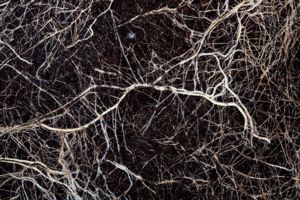"Sticky roots" and the fate of soil carbon in natural ecosystems
Human activities are driving increasing concentrations of CO2 into the atmosphere. The good news is that nature has built-in mechanisms operating in ecosystems that can transform atmospheric CO2 into organic forms and store it in soil long term.
In particular, organic matter can become bound to or "stick" to soil minerals, where it can remain protected for millennia. Such long-term protection has great value to humans as our climate changes. However, the growth of living plants and soil microbes may depend on accessing nutrients trapped in the mineral-associated organic matter.

Michigan State University plant biologist Carolyn Malmstrom is part of a team of scientists that is using a 3-year, $1 million Department of Energy (DOE) Office of Science Environmental Systems Science Program award to study "sticky roots" and the fate of soil carbon in natural ecosystems. The grant began on August 15.
The DOE allocated $6 million in Fiscal Year 2020 for nine collaborative projects to study the complex chemical, physical, and biological processes in watersheds, salt marshes, wetlands, and a range of other terrestrial environments to improve representation of these processes in earth system models.MSU's portion of this collaborative grant is $224,982.
Malmstrom, MSU co-principal investigator (Co-PI), is teaming up with project PI Zoe Cardon, the Ecosystems Center, Marine Biological Laboratory, Woods Hole, Mass.; and Co-PIs Marco Keiluweit, University of Massachusetts Amherst; and William Riley, Lawrence Berkeley National Laboratory, to use experiments and modeling to examine the mechanisms by which plant roots and their associated microbes can dislodge organic matter from soil minerals.
"This is an exciting project because to my knowledge, this is the first major project anywhere to look at plant virus impact on biogeochemical cycling on land," said Malmstrom, associate professor in the Department of Plant Biology and the Ecology, Evolution, and Behavior Program.
"Viruses are found everywhere in nature but have been long overlooked," she explained. "We are using viruses as a tool to manipulate root carbon secretions. When carbon in organic matter in the soil gets bound up with minerals, it is protected from release to the atmosphere. The question is how this protected carbon can be influenced, and perhaps released, by plant roots."



